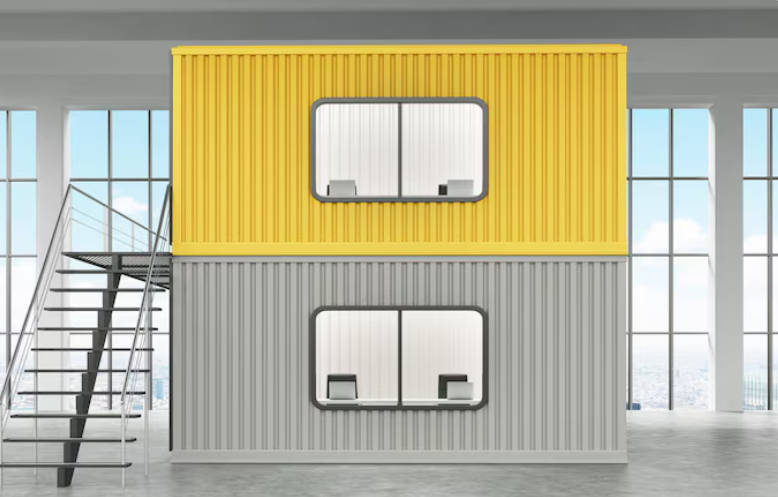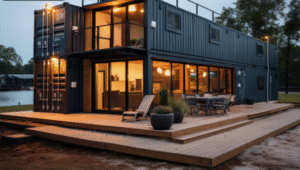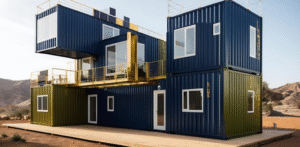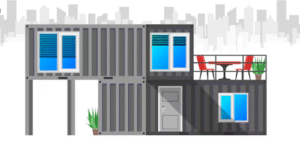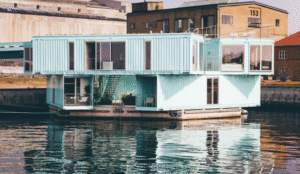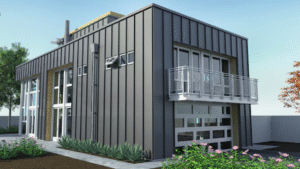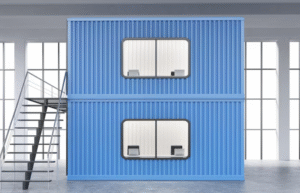The United Arab Emirates (UAE) is a global hub for innovative construction, characterized by ambitious mega-projects, rapid urbanization, and a commitment to sustainability. From towering skyscrapers in Dubai to sprawling infrastructure developments in Abu Dhabi, the UAE’s construction industry demands solutions that are efficient, adaptable, and environmentally responsible. Enter containers for construction—repurposed or custom-designed steel units that serve as site offices, storage facilities, worker accommodations, and specialized structures. These modular units have revolutionized construction practices in the UAE, offering a blend of durability, flexibility, and eco-friendliness that aligns with the nation’s vision for progress.
Containers, originally designed for global shipping, are constructed from corten steel, a weather-resistant material capable of withstanding the UAE’s extreme climate—temperatures exceeding 45°C, high humidity, and frequent sandstorms. Their prefabricated nature allows for rapid deployment, often within days, compared to months for traditional buildings. This speed is critical in the UAE, where projects like airports, highways, and cultural landmarks operate on tight schedules. Moreover, containers support the UAE’s sustainability goals, such as Vision 2030, by repurposing existing materials, reducing waste, and incorporating energy-efficient features.
This guide provides an exhaustive exploration of containers for construction in the UAE, covering their benefits, types, applications, regulations, and emerging trends. It is designed for construction professionals, including project managers, architects, engineers, and procurement officers, seeking comprehensive insights into modular solutions. From technical specifications to cultural relevance, this article delves into every facet of container use, ensuring you have the knowledge to leverage these structures effectively in your projects.
Benefits of Using Containers for Construction
Containers offer a multitude of advantages that make them indispensable for UAE construction sites. Their unique properties address the challenges of cost, durability, sustainability, and operational efficiency, making them a preferred choice for modern projects.
Cost-Effectiveness
Traditional construction involves significant expenses for materials, labor, and site preparation. Containers, often repurposed from shipping units, reduce these costs by providing a ready-made structure that requires minimal on-site work. Their modular design eliminates the need for extensive foundations or complex assemblies, saving time and resources. In the UAE, where large-scale projects demand budget-conscious solutions, containers offer a cost-effective alternative without sacrificing quality or functionality.
Durability and Climate Resilience
The UAE’s desert environment poses unique challenges, including extreme heat, sandstorms, and high humidity. Containers are built from corten steel, a corrosion-resistant alloy designed to endure harsh marine conditions during global transport. This durability translates to construction sites, where containers withstand temperature fluctuations, abrasive sand, and moisture. Their robust construction ensures long-term performance, even in remote or coastal areas like Al Ain or Fujairah.
Sustainability
Sustainability is a cornerstone of UAE’s construction policies, with initiatives like Estidama and Dubai’s Green Building Regulations emphasizing eco-friendly practices. Containers contribute by repurposing existing steel units, reducing the need for new materials. A single 40-foot container can save approximately 3,500 kg of steel, minimizing resource extraction and landfill waste. Additionally, containers can be fitted with energy-saving features, such as insulation, solar panels, and LED lighting, aligning with the UAE’s goal of reducing carbon emissions by 30% by 2030.
Portability and Mobility
Construction projects in the UAE often span multiple phases or locations, requiring structures that can be relocated easily. Containers are designed for transport, with standardized dimensions that fit trucks, cranes, or ships. This portability allows contractors to move offices, storage units, or accommodations to new sites without dismantling or rebuilding. In urban centers like Dubai or remote regions like Liwa, this flexibility streamlines project logistics.
Speed of Deployment
Time is a critical factor in the UAE’s fast-paced construction industry. Containers can be delivered and operational within days, compared to weeks or months for traditional structures. Their prefabricated design requires minimal on-site assembly, enabling immediate use for offices, storage, or housing. This rapid deployment is particularly valuable for time-sensitive projects, such as infrastructure developments or event-related constructions.
Customization Versatility
Containers are highly customizable, allowing for tailored solutions to meet project-specific needs. Modifications include adding windows, doors, insulation, plumbing, electrical systems, and aesthetic finishes. In the UAE, where projects range from utilitarian worker camps to luxurious temporary offices, containers can be adapted to suit diverse functional and aesthetic requirements, ensuring both practicality and visual appeal.
Scalability
Containers can be stacked or combined to create larger structures, such as multi-story offices or expansive storage facilities. This scalability is ideal for the UAE’s mega-projects, where space and functionality needs evolve over time. Modular designs allow contractors to expand or reconfigure layouts as projects progress, ensuring adaptability to changing demands.
Types of Containers for Construction
Containers come in various types, each designed to address specific construction needs. Understanding their specifications and applications is crucial for selecting the right units for UAE projects.
Standard Shipping Containers
Standard containers, available in 20-foot (6.1m x 2.44m x 2.59m) and 40-foot (12.2m x 2.44m x 2.59m) sizes, are the most common choice for construction. They are used for storage, site offices, and basic accommodations. Their corten steel construction ensures durability, while their standardized dimensions enable easy transport and stacking. High cube variants, with an extra foot of height (2.89m), offer additional vertical space for equipment or personnel.
ISO Tank Containers
ISO tank containers are cylindrical tanks encased in a steel frame, designed for storing and transporting liquids or gases, such as water, fuel, or chemicals. In construction, they are critical for managing resources on oil and gas projects or remote sites. These containers comply with international standards, ensuring safe handling of hazardous materials. Their robust design withstands the UAE’s extreme conditions, making them ideal for industrial applications.
Reefer Containers
Refrigerated containers, or reefers, feature built-in cooling systems to maintain specific temperatures. They are used to store perishable supplies, such as food for worker camps, or temperature-sensitive materials, like adhesives or paints. In the UAE’s hot climate, where temperatures can degrade materials, reefers ensure quality and safety. They typically operate at temperatures from -30°C to +30°C, with precise controls for reliability.
High Cube Containers
High cube containers, measuring 20 or 40 feet in length and 9.5 feet in height, provide extra vertical space compared to standard units. They are ideal for projects requiring taller interiors, such as equipment storage or multi-level offices. Their additional height accommodates larger machinery or enhanced ventilation systems, crucial for UAE’s warm climate.
Open-Top Containers
Open-top containers feature a removable or tarp-covered roof, allowing for easy loading of oversized equipment or materials. They are used to transport heavy items, such as steel beams or cranes, to construction sites. In the UAE, where large-scale projects involve bulky components, open-top containers simplify logistics and reduce handling costs.
Flat Rack Containers
Flat rack containers have collapsible sides, providing a flat platform for oversized or irregularly shaped cargo. They are used for transporting heavy machinery, such as excavators or generators, to UAE construction sites. Their flexibility allows for secure loading and unloading, making them suitable for complex logistical needs.
Custom Containers
Custom containers are modified to meet specific project requirements, such as site offices, ablution units, or medical facilities. Modifications include insulation, windows, doors, HVAC systems, plumbing, and aesthetic finishes like wood paneling or glass facades. In the UAE, where projects demand both functionality and visual appeal, custom containers offer tailored solutions for diverse applications.
Double-Door Containers
Double-door containers feature access points at both ends, facilitating easy loading and unloading. They are used for storage or as pass-through facilities on construction sites, improving workflow efficiency. Their design is particularly useful for UAE projects requiring frequent access to materials.
Applications of Containers in UAE Construction Sites
Containers serve a wide array of functions on UAE construction sites, addressing operational, logistical, and human needs. Their versatility makes them suitable for projects ranging from urban skyscrapers to remote infrastructure developments.
Site Offices
Containers are converted into fully equipped site offices, serving as administrative hubs for project managers, engineers, and supervisors. These offices include desks, chairs, air conditioning, lighting, and internet connectivity, creating a professional workspace. Their mobility allows relocation as construction phases shift, ensuring proximity to active zones. In the UAE, where projects like highways or cultural landmarks require centralized oversight, container offices enhance efficiency.
Storage Units
Secure storage is essential to protect tools, materials, and equipment from theft, weather, or damage. Containers offer lockable, weather-resistant storage solutions, with corten steel walls preventing unauthorized access. Their portability allows repositioning as site layouts change, while their durability withstands the UAE’s harsh climate, safeguarding valuable assets.
Worker Accommodation
Large-scale projects in remote areas, such as desert highways or coastal developments, require on-site housing for workers. Containers are transformed into comfortable accommodations with beds, bathrooms, kitchens, and climate control. These units comply with UAE labor regulations, ensuring hygienic and safe living conditions. Modular designs allow for scalable camps, accommodating workforces of varying sizes.
Ablution Units
Hygiene is a priority on construction sites, particularly in the UAE, where regulations mandate adequate facilities for workers. Containers are modified into ablution units with toilets, showers, sinks, and ventilation systems. Water-resistant interiors and plumbing connections ensure functionality, while their portability allows placement near worker camps or active zones.
Break Rooms and Canteens
UAE labor laws require rest areas for workers, and containers serve as break rooms or canteens. Equipped with seating, tables, cooling systems, and sometimes kitchen facilities, these spaces provide a comfortable environment for meals and rest. Their design can be customized to reflect project branding or cultural preferences, enhancing worker satisfaction.
Specialized Facilities
Containers are adapted for specialized purposes, such as command centers for project oversight, medical units for on-site healthcare, or laboratories for material testing. Command centers include advanced communication systems, while medical units feature sterilization equipment and beds. In the UAE, where complex projects demand centralized operations, these facilities streamline workflows and ensure safety.
Security Cabins
Containers are used as security cabins, housing guards and monitoring equipment at site entrances or perimeters. Equipped with windows, lighting, and security systems, these cabins enhance site safety, a critical concern in the UAE’s high-value projects.
Temporary Retail and Exhibition Spaces
For construction-related events or expos, containers are converted into retail shops or exhibition booths. Their aesthetic customization, such as branded facades or glass windows, attracts visitors while showcasing project innovations. These spaces are common in the UAE, where events like construction expos drive industry engagement.
Regulations and Standards for Construction Containers
The UAE enforces stringent regulations to ensure safety, sustainability, and compliance in construction. Containers must adhere to local and international standards, reflecting the country’s commitment to quality and environmental responsibility.
Green Building Standards
The UAE’s sustainability initiatives, such as Abu Dhabi’s Estidama and Dubai’s Green Building Regulations, promote eco-friendly construction. Containers align with these standards by reducing material waste and incorporating energy-efficient features like insulation, solar panels, and low-energy lighting. Compliance with these codes enhances project eligibility for green certifications, supporting the UAE’s environmental goals.
Safety Standards
Containers used for accommodation or offices must meet UAE health and safety regulations, prioritizing worker welfare. This includes adequate ventilation, fire-resistant materials, and safe electrical systems. Regular inspections ensure structural integrity, particularly for stacked or modified units, preventing accidents in the UAE’s demanding construction environment.
International Certifications
Containers often comply with ISO standards, ensuring structural quality and safety. ISO tank containers, used for hazardous materials, meet additional requirements for secure transport and storage. These certifications are critical in the UAE, where oil and gas projects require strict compliance to prevent environmental or safety risks.
Import and Customs Regulations
Imported containers are subject to a 5% GCC customs duty, requiring documentation for origin, material composition, and intended use. Construction companies must coordinate with customs authorities to ensure compliance, particularly for specialized units like reefers or ISO tanks. Efficient customs processes at UAE ports facilitate timely delivery.
Local Zoning and Permitting
Municipalities in Dubai, Abu Dhabi, and other emirates enforce zoning regulations for container placement, ensuring they do not obstruct traffic or violate aesthetic standards. Permits are required for on-site installation, particularly in urban areas. Early coordination with local authorities prevents delays and ensures compliance.
Labor Regulations
Containers used for worker accommodations must comply with UAE labor laws, mandating safe, hygienic, and comfortable living conditions. This includes proper ventilation, sanitation, and space per worker, ensuring compliance with regulations enforced by the Ministry of Human Resources and Emiratisation.
Cost Analysis and Budgeting for Construction Containers
Understanding cost factors and budgeting strategies is essential for integrating containers into UAE construction projects, despite avoiding specific pricing details.
Factors Influencing Costs
Costs vary based on container size (e.g., 20-foot vs. 40-foot), type (e.g., standard vs. reefer), and customization level. Modifications like insulation, plumbing, or aesthetic finishes increase expenses but enhance functionality. Transportation costs depend on site location, with remote areas like Al Gharbia requiring higher logistics budgets. Installation, including crane or foundation work, also impacts costs.
Rental vs. Purchase Options
Renting containers suits short-term projects, offering flexibility without long-term investment. Purchasing is ideal for recurring or permanent needs, allowing reuse across multiple sites. Both options require budgeting for delivery, setup, and potential maintenance, tailored to project timelines and scope.
Long-Term Savings
Containers offer significant savings over traditional construction due to their prefabricated nature, reducing material and labor costs. Their durability minimizes maintenance expenses, while their portability eliminates the need for new structures at each site. Energy-efficient features, such as insulation or solar panels, reduce operational costs, particularly in the UAE’s energy-intensive climate.
Budgeting Strategies
Effective budgeting involves assessing project needs early, determining the number and type of containers required. Comparing rental and purchase options, factoring in logistics, and planning for maintenance streamline costs. Consulting with suppliers to align customizations with project goals ensures cost-efficiency without compromising quality.
Hidden Costs
Consider potential hidden costs, such as permits, customs duties, or modifications for UAE-specific conditions (e.g., enhanced cooling systems). Proactive planning, including contingency budgets, mitigates these expenses and ensures smooth project execution.
Sustainability and Eco-Friendly Practices
Containers are a sustainable choice for UAE construction, aligning with the nation’s environmental goals and reducing the ecological footprint of projects.
Upcycling and Resource Conservation
Repurposing shipping containers conserves resources by reusing existing steel units. This reduces the need for new materials, saving thousands of kilograms of steel per container and minimizing mining impacts. Upcycling supports the UAE’s circular economy initiatives, promoting sustainable resource use.
Energy Efficiency
Containers can be retrofitted with energy-efficient features, such as high-quality insulation, double-glazed windows, and solar panels. These modifications reduce energy consumption for cooling and lighting, critical in the UAE’s hot climate. Smart HVAC systems and LED lighting further enhance efficiency, lowering carbon emissions.
Reduced Construction Waste
Traditional construction generates significant waste, including concrete, wood, and packaging materials. Containers, being prefabricated, produce minimal on-site waste, supporting the UAE’s zero-waste goals. Their modular design allows for precise planning, reducing excess materials.
Alignment with UAE Sustainability Goals
The UAE aims to reduce carbon emissions by 30% by 2030, and containers contribute by minimizing construction-related emissions. Their adaptability supports green certifications like Estidama or LEED, enhancing project credibility in sustainable development.
Water Conservation
In water-scarce regions like the UAE, containers can be equipped with water-saving fixtures, such as low-flow toilets or greywater recycling systems, for ablution units or accommodations. These features align with national water conservation efforts, reducing environmental strain.
Case Studies and Success Stories
While specific projects are not named, the following scenarios illustrate how containers are applied in UAE construction, highlighting their practical benefits and versatility.
Urban Infrastructure Project
In a major urban infrastructure project, such as a metro expansion, containers serve as centralized site offices. Equipped with advanced communication systems, air conditioning, and ergonomic furniture, these offices support project coordination. Their mobility allows relocation as construction moves along the project corridor, ensuring operational continuity.
Remote Desert Development
For a highway project in a remote desert region, containers provide worker accommodations. Fitted with beds, bathrooms, and solar-powered cooling, these units ensure compliance with labor regulations while offering comfort in harsh conditions. Their modular design allows for scalable camps, accommodating hundreds of workers.
Cultural Event Setup
During a construction-related expo, containers are converted into exhibition booths showcasing innovative materials. Customized with glass facades and branded signage, these units attract visitors while demonstrating the versatility of modular construction. Their portability enables rapid setup and removal.
Emergency Response Facility
In a time-sensitive scenario, such as a construction site incident, containers are deployed as medical units. Equipped with sterilization equipment, beds, and ventilation, these units provide on-site healthcare, ensuring rapid response and worker safety.
Temporary Community Space
In a rapidly developing urban area, containers are used as temporary community centers, hosting workshops or cultural events. Their aesthetic customization, including vibrant exteriors and modern interiors, fosters community engagement, aligning with the UAE’s social development goals.
Future Trends in Container Construction in the UAE
The future of container construction in the UAE is shaped by technological advancements, sustainability priorities, and evolving project demands, positioning containers as a cornerstone of innovation.
Modular and Multi-Story Architecture
The UAE’s focus on space-efficient design is driving the use of multi-story container structures. Stacked containers create offices, accommodations, or commercial spaces, maximizing land use in urban areas like Dubai. Advanced engineering ensures structural stability, while aesthetic finishes align with the UAE’s architectural standards.
Smart Technology Integration
Internet of Things (IoT) sensors enable real-time monitoring of temperature, humidity, and security in containers, ensuring optimal conditions for materials or workers. Smart HVAC systems adjust settings dynamically, reducing energy consumption. These technologies align with the UAE’s vision as a global tech hub.
Sustainable Innovations
Emerging materials, such as advanced insulation or green roofing, enhance container sustainability. Solar panels and energy storage systems are increasingly integrated, reducing reliance on fossil fuels. These innovations support the UAE’s goal of achieving net-zero emissions in construction.
Automation in Logistics
Automated vehicles, such as autonomous trucks or drones, streamline container delivery to UAE sites. Real-time tracking systems ensure transparency, reducing delays. These advancements leverage the UAE’s advanced logistics infrastructure, centered around ports like Jebel Ali.
Circular Economy Integration
The UAE’s circular economy initiatives promote container reuse and recycling. Future trends include standardized designs for easy disassembly and repurposing, extending container lifecycles and reducing waste.
How to Choose the Right Container Supplier in the UAE
Selecting a supplier for construction containers requires careful consideration of several factors to ensure quality, compliance, and project success.
Experience and Technical Expertise
Suppliers with extensive experience in container conversion understand the UAE’s construction challenges, including climate and regulatory requirements. They should demonstrate expertise in designing and modifying containers for diverse applications, from offices to specialized facilities.
Customization Capabilities
Suppliers must offer flexible customization options, such as insulation, plumbing, electrical systems, or aesthetic enhancements. This ensures containers meet project-specific needs, whether for functional storage or luxurious offices.
Regulatory Compliance
Suppliers should provide containers that comply with UAE regulations, including green building codes, safety standards, and labor laws. Certifications like ISO or safety approvals validate quality and ensure regulatory adherence.
Logistics and Support Services
Efficient delivery and setup are critical in the UAE’s fast-paced construction environment. Suppliers should offer reliable logistics, including transportation to remote sites, and provide ongoing maintenance or technical support.
Sustainability Commitment
Suppliers prioritizing eco-friendly practices, such as upcycling or energy-efficient modifications, align with the UAE’s sustainability goals. Their commitment to green construction enhances project credibility and environmental impact.
Quality Assurance
Suppliers should conduct rigorous quality checks, ensuring containers are free from defects like corrosion or structural weaknesses. Third-party inspections or certifications provide additional assurance of durability and safety.
Logistics and Transportation of Construction Containers
The UAE’s advanced logistics infrastructure facilitates the efficient transport of containers to construction sites, ensuring timely project execution.
Role of UAE Ports
The UAE’s ports, handling millions of containers annually, are central to the supply chain. Containers are imported or locally sourced, with streamlined customs processes ensuring rapid clearance. Efficient port operations minimize delays, critical for time-sensitive projects.
Transportation Methods
Containers are transported via trucks, flatbed trailers, or cranes, depending on site accessibility. In urban areas like Dubai, trucks navigate regulated routes, while remote sites require specialized vehicles. Coordination with logistics providers ensures safe and timely delivery.
Customs and Documentation
Imported containers require documentation, including bills of lading, certificates of origin, and material specifications. Compliance with GCC customs regulations, including a 5% duty, is essential to avoid delays. Suppliers often assist with customs clearance, streamlining the process.
Challenges and Solutions
Logistical challenges include navigating urban traffic, securing road permits, or delivering to remote areas like the Empty Quarter. Solutions include real-time tracking, partnerships with logistics firms, and pre-planned routes to ensure on-time delivery.
On-Site Setup and Installation
Containers require minimal setup, with cranes or forklifts positioning units on-site. Suppliers may provide installation services for utilities like plumbing or electricity, ensuring immediate functionality. In the UAE, where rapid deployment is critical, this streamlined process enhances efficiency.
Design Trends in Container Construction
Container design in the UAE combines functionality with aesthetic innovation, reflecting the nation’s reputation for architectural excellence.
Modern and Minimalist Interiors
Containers are transformed into modern interiors with open floor plans, large windows, and sleek finishes. Materials like wood paneling, glass, or stainless steel create professional or inviting spaces, suitable for offices or break rooms. In the UAE, minimalist designs align with contemporary architectural trends.
Branding and Aesthetic Customization
For commercial or event-related projects, containers are customized with branded facades, logos, or vibrant colors. This enhances visibility and aligns with project identities, particularly for expos or temporary retail spaces in the UAE.
Multi-Story and Modular Designs
Stacking containers to create multi-story structures maximizes space on compact sites. Advanced engineering ensures stability, while modular layouts allow for flexible configurations. In the UAE, where land is valuable, these designs optimize urban and industrial spaces.
Sustainable Design Features
Green roofs, solar panels, and energy-efficient insulation are integrated into containers, reducing environmental impact. Water-saving fixtures, such as low-flow toilets, support the UAE’s conservation efforts. These features enhance sustainability and aesthetic appeal.
Cultural Aesthetics
Container designs often incorporate elements of UAE culture, such as geometric patterns or Arabic motifs, blending modern functionality with traditional aesthetics. This approach resonates with the UAE’s emphasis on cultural identity in architecture.
Safety Considerations for Construction Containers
Safety is paramount on UAE construction sites, and containers must meet rigorous standards to protect workers and assets.
Structural Integrity
Containers must be inspected for corrosion, weld strength, and structural damage, particularly in the UAE’s harsh climate. Regular maintenance ensures stability, especially for stacked or modified units, preventing collapses or accidents.
Fire Safety
Fire-resistant materials, such as insulated panels and non-combustible fittings, are critical for containers used as offices or accommodations. Fire extinguishers, smoke detectors, and clear evacuation routes comply with UAE safety regulations, reducing fire risks.
Ventilation and Climate Control
Adequate ventilation and cooling are essential in the UAE’s hot climate, where temperatures can exceed 45°C. Containers must include air conditioning, fans, or natural ventilation systems to ensure worker comfort and prevent heat-related illnesses.
Electrical and Plumbing Safety
Modified containers with electrical or plumbing systems must adhere to UAE building codes. Proper grounding, circuit protection, and leak-proof plumbing prevent hazards, ensuring safe operation for offices or accommodations.
Worker Ergonomics
Containers used for offices or break rooms should be designed with ergonomic furniture, adequate lighting, and noise control to enhance worker productivity and well-being. Compliance with UAE labor laws ensures a safe and comfortable environment.
Cultural and Social Relevance in the UAE
Containers resonate with the UAE’s cultural and social context, supporting its rapid urbanization and innovation-driven ethos.
Supporting Rapid Urbanization
The UAE’s population growth and urban expansion, particularly in Dubai and Abu Dhabi, drive the need for flexible construction solutions. Containers provide temporary offices, housing, and facilities, enabling projects to keep pace with the country’s ambitious development goals.
Innovation and Modernity
The UAE’s culture of innovation embraces containers as a modern, sustainable solution. Their use in cutting-edge projects, such as pop-up retail or smart offices, reflects the nation’s forward-thinking approach to construction and design.
Community Engagement
Containers are used for community initiatives, such as mobile clinics, libraries, or event spaces, fostering social cohesion. In the UAE, where community development is a priority, these applications enhance public engagement and accessibility.
Cultural Integration
Containers can be designed with elements of Emirati culture, such as mashrabiya-inspired facades or desert-inspired color palettes. This integration ensures they resonate with local communities while meeting functional needs.
Financing Options for Construction Containers
Financing containers involves strategic planning to align with project budgets and timelines, enhancing cost-efficiency.
Leasing Programs
Leasing containers is ideal for short-term projects, offering flexibility without long-term investment. Lease agreements may include maintenance, delivery, and setup services, reducing operational burdens. This option suits the UAE’s dynamic project landscape.
Bank Loans and Financing
Construction companies can secure loans from UAE banks to purchase containers for long-term use. Financing spreads costs over time, making it feasible for large-scale or recurring projects. Interest rates and terms vary, requiring careful evaluation.
Government Incentives
The UAE offers incentives for sustainable construction, such as tax benefits or grants for green projects. Containers, with their eco-friendly attributes, may qualify for these programs, reducing financial burdens and supporting national goals.
Return on Investment (ROI)
Investing in containers offers long-term returns due to their durability and reusability. Their low maintenance and relocation costs make them a cost-effective choice for multiple projects, enhancing ROI for contractors.
Budget Planning
Effective financing involves assessing project scope, determining container needs, and comparing leasing vs. purchase options. Budgets should account for logistics, customization, and maintenance, with contingency funds for unforeseen expenses.
Maintenance and Upkeep of Construction Containers
Proper maintenance ensures containers remain functional, safe, and aesthetically pleasing throughout their use on UAE construction sites.
Regular Inspections
Containers should be inspected quarterly for corrosion, structural damage, or wear, particularly in the UAE’s harsh climate. Checks focus on welds, flooring, and roofing, ensuring stability and compliance with safety standards.
Cleaning and Hygiene
Containers used for accommodations or canteens require regular cleaning to maintain hygiene. Water-resistant interiors and pest control treatments prevent infestations, protecting workers and materials. In the UAE, where hygiene is regulated, these measures are critical.
Utility Maintenance
Electrical, plumbing, and HVAC systems require periodic servicing to ensure functionality. In the UAE’s hot climate, cooling systems are stressed, necessitating regular filter cleaning and refrigerant checks to prevent breakdowns.
Repairs and Upgrades
Minor repairs, such as fixing dents or sealing leaks, maintain container integrity. Upgrades, like adding insulation or modern fittings, enhance performance and aesthetics, extending container lifecycles.
Protective Coatings
Applying anti-corrosion coatings or weather-resistant paints protects containers from the UAE’s sandstorms and humidity. These coatings preserve structural integrity and maintain visual appeal.
Technology Integration in Container Construction
Technology is transforming container construction, enhancing functionality and efficiency on UAE sites.
IoT and Smart Systems
IoT sensors monitor temperature, humidity, and security, ensuring optimal conditions for materials or workers. Smart HVAC systems adjust settings automatically, reducing energy consumption. These technologies align with the UAE’s smart city initiatives.
Automation in Logistics
Automated vehicles, such as autonomous trucks or drones, streamline container delivery. Real-time tracking systems provide transparency, reducing delays. In the UAE, where logistics is a key industry, these advancements enhance project efficiency.
3D Design Software
Advanced design software enables architects to create precise container layouts, optimizing space and functionality. Virtual reality tools allow stakeholders to visualize designs before implementation, ensuring alignment with project goals.
Blockchain for Supply Chain
Blockchain technology ensures transparency in container sourcing, tracking materials from origin to site. This aligns with the UAE’s focus on digital transformation, enhancing trust and efficiency in logistics.
Energy Management Systems
Smart energy systems, such as solar-powered batteries or energy-efficient lighting, reduce container energy consumption. These systems support the UAE’s sustainability goals, minimizing environmental impact.
Challenges and Limitations of Container Construction
Despite their benefits, containers present challenges that require proactive solutions to ensure successful implementation.
Space Constraints
Containers have fixed dimensions, limiting interior space. Solutions include stacking units, combining multiple containers, or using high cube models to maximize capacity. Careful planning ensures spatial needs are met.
Regulatory Hurdles
Zoning laws and permitting requirements in the UAE can complicate container placement, particularly in urban areas. Early coordination with municipalities and compliance with regulations prevent delays or penalties.
Perception Challenges
Some stakeholders view containers as temporary or low-quality structures. High-quality customizations, such as modern interiors or branded facades, and education about their durability can shift perceptions.
Environmental Adaptation
The UAE’s extreme climate requires modifications like enhanced insulation or cooling systems to ensure container performance. These adaptations add complexity but are essential for functionality.
Logistical Challenges
Transporting containers to remote sites, such as desert regions, can be challenging due to infrastructure limitations. Partnerships with experienced logistics providers and advanced planning mitigate these issues.
Container Construction for Mega Projects in the UAE
Containers play a critical role in the UAE’s mega-projects, supporting large-scale developments with their scalability and efficiency.
Infrastructure Developments
Major infrastructure projects, such as highways or airports, use containers for site offices, storage, and worker camps. Their rapid deployment supports tight schedules, while their mobility ensures flexibility across expansive sites.
Mixed-Use Developments
In mixed-use developments, containers serve as temporary offices, retail spaces, or community facilities during phased construction. Their aesthetic customization enhances project branding, aligning with the UAE’s urban aesthetic.
Cultural and Event Projects
Containers are used in expos or cultural events, providing exhibition booths, rest areas, or ticketing offices. Their portability and rapid setup make them ideal for temporary setups, common in the UAE’s event-driven landscape.
Remote Project Support
In remote areas, containers provide self-contained facilities, including accommodations, medical units, or command centers. Their durability and adaptability ensure functionality in challenging environments.
Comparison with Traditional Construction Methods
Containers offer distinct advantages over traditional construction, making them a compelling choice for UAE projects.
Speed of Construction
Containers can be deployed in days, compared to months for traditional buildings. This speed is critical for the UAE’s time-sensitive projects, ensuring rapid progress without compromising quality.
Cost Efficiency
The prefabricated nature of containers reduces material and labor costs, offering savings over concrete or steel-frame construction. Their reusability across projects further enhances cost-effectiveness.
Environmental Impact
Containers minimize waste and energy use, aligning with the UAE’s sustainability goals. Traditional construction generates more waste and requires extensive resources, increasing environmental impact.
Flexibility and Adaptability
Containers can be relocated, reconfigured, or repurposed, unlike fixed buildings. This adaptability suits the UAE’s dynamic project landscape, where needs evolve rapidly.
Aesthetic Versatility
While traditional buildings offer design flexibility, containers can achieve similar aesthetics through customization, such as glass facades or modern finishes, at a lower cost and faster timeline.
Containers in Disaster Relief and Emergency Situations
Containers are invaluable in emergency scenarios, providing rapid and reliable solutions for UAE construction sites.
Temporary Shelters
In disaster relief, containers are converted into shelters for displaced workers or communities. Equipped with beds, sanitation, and climate control, they offer safe and durable housing, deployable within hours.
Mobile Medical Units
Containers serve as mobile medical units, fitted with sterilization equipment, beds, and diagnostic tools. Their quick deployment ensures immediate healthcare support during site incidents or regional emergencies.
Command Centers
During emergencies, containers function as command centers, housing communication systems and coordination teams. Their mobility allows strategic placement, enhancing response efficiency.
Storage for Relief Supplies
Containers provide secure storage for emergency supplies, such as food, water, or medical equipment. Their weather-resistant design protects assets, ensuring availability during crises.
Community and Educational Uses of Containers
Beyond construction, containers support community and educational initiatives in the UAE, enhancing accessibility and engagement.
Mobile Classrooms
Containers are transformed into mobile classrooms for remote or temporary educational programs. Equipped with desks, whiteboards, and cooling systems, they support the UAE’s goal of accessible education.
Community Centers
Converted containers serve as community hubs, hosting workshops, cultural events, or social services. Their mobility makes them ideal for outreach programs in underserved areas.
Pop-Up Libraries
Containers are used as mobile libraries, bringing books and digital resources to communities. Their aesthetic customization, such as vibrant exteriors, encourages public participation.
Training Facilities
Containers are converted into training centers for construction skills or vocational programs, supporting the UAE’s workforce development initiatives. Their portability allows deployment in urban or rural areas.
Export and Import of Containers in the UAE
The UAE’s role as a global trade hub facilitates container sourcing and distribution for construction projects.
Import Processes
Containers are imported through major ports, with efficient customs processes ensuring rapid clearance. Documentation, including bills of lading and material certifications, ensures compliance with UAE regulations.
Local Manufacturing
Some containers are manufactured locally, tailored to UAE-specific needs, such as enhanced insulation for heat resistance. Local production reduces import costs and supports the economy.
Export Opportunities
The UAE exports containers to neighboring countries, leveraging its logistics infrastructure. This supports construction projects across the GCC, enhancing regional connectivity.
Trade Regulations
Compliance with GCC customs duties (5%) and international trade standards is essential. Suppliers coordinate with authorities to ensure seamless import and export processes.
Training and Certification for Container Conversion
Skilled labor is critical for container conversion, ensuring quality and compliance in UAE projects.
Training Programs
Training programs cover container design, modification, and regulatory compliance, equipping architects and engineers with specialized skills. Topics include structural engineering, insulation techniques, and aesthetic customization.
Certifications
International certifications, such as ISO or safety standards, validate container quality. Training ensures compliance with UAE regulations, including green building codes and labor laws.
Workforce Development
The UAE’s focus on workforce development includes programs for modular construction, fostering expertise in container-based projects. Partnerships with educational institutions enhance access to training.
Practical Applications
Training emphasizes hands-on skills, such as welding, plumbing, or electrical installation, ensuring high-quality conversions. Trainees learn to adapt containers for UAE-specific conditions, like extreme heat.
Customer Testimonials and Reviews
Feedback from construction professionals highlights the value of containers, building trust in their applications.
Project Manager Insights
Managers value containers for their speed and cost-effectiveness, noting their role in meeting tight deadlines and budgets. Their portability simplifies logistics across multi-phase projects.
Worker Feedback
Workers appreciate container accommodations for their comfort, safety, and hygiene, particularly in remote UAE sites. Features like air conditioning and sanitation enhance their well-being.
Architect Perspectives
Architects praise containers for their design flexibility, enabling innovative and sustainable structures. Customized interiors and exteriors align with the UAE’s architectural standards.
Engineer Testimonials
Engineers highlight the structural reliability and ease of modification, noting containers’ ability to withstand harsh conditions while supporting complex project needs.
Conclusion and Call to Action
Containers for construction in the UAE are a game-changer, offering unmatched versatility, sustainability, and efficiency. From site offices to disaster relief units, their applications span the spectrum of construction needs, aligning with the UAE’s vision for innovation and environmental responsibility. As the industry evolves, containers will continue to shape the future, driven by technological advancements and sustainable practices.
Explore container solutions for your next project. Consult with suppliers to customize units for your needs, review case studies for inspiration, and leverage the UAE’s logistics network to bring your vision to life. Build smarter, greener, and faster with containers, and contribute to the UAE’s legacy of excellence in construction.
